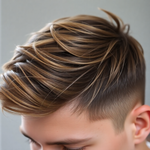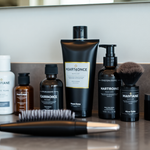
Low-Waste Color Lab: Experiment with Semi‑Permanent Hair Color to Optimize Your Sustainable Men's Capsule Wardrobe
06 September 2025
Share
Intro — Keep your look sharp, waste low
Struggling to refresh your style without buying new clothes or producing more waste? "Low-Waste Color Lab: Experiment with Semi‑Permanent Hair Color to Optimize Your Sustainable Men's Capsule Wardrobe" shows how a few mindful color experiments can make a small capsule wardrobe feel new, intentional, and low-impact. This guide blends color science, sustainable grooming habits, and practical steps so you can test looks at home with minimal waste.
Why semi-permanent color is a sustainable style lever
Semi-permanent hair dye (also called semi-permanent hair color) deposits pigments on the hair surface without the oxidative chemistry of permanent dyes. That means:
- Less damage to hair fibers, lengthening garment-like longevity in your daily look.
- Faster fade cycles—perfect for low-commitment experiments that won't overwhelm your capsule aesthetic.
- Fewer salon visits and boxed treatments over time, reducing single-use packaging and transport emissions.
Used strategically, semi-permanent color becomes a texture-and-tone tool that helps existing pieces in your sustainable men's capsule wardrobe read differently without buying more.
Low-Waste Color Lab: Experiment with Semi‑Permanent Hair Color to Optimize Your Sustainable Men's Capsule Wardrobe
This section walks through a full, repeatable lab-style process—planning, testing, applying, documenting, and maintaining—so you can experiment without wasting money, product, or time. The primary keyword appears here to keep your on-page SEO tight and focused.
Part 1 — Plan your experiment
Before you touch product, identify your goals and constraints. Planning reduces wasted product and prevents impulsive re-dyes.
- Define the goal: camouflage greys, warm your complexion, or add contrast to a monochrome capsule?
- Inventory your wardrobe: note dominant colors (navy, grey, olive, black), textures (wool, denim), and statement pieces.
- Pick an intensity: subtle lift (1–2 levels), visible shift, or creative color (tints and tones).
- Set a waste budget: how much packaging you’ll allow per session (e.g., use refillable or minimal-packaging brands).
Part 2 — Choose shade by face tone, hair base, and capsule colors
Color theory helps you choose shades that harmonize with your clothes and skin. Two secondary keywords to keep in mind: sustainable men's capsule wardrobe and semi-permanent hair dye.
- Cool skin tones: look best with ash, cool browns, and blue-black shades that pair well with greys and navy.
- Warm skin tones: enhanced by golden browns, warm chestnuts, or subtle copper—excellent with earth tones and olive.
- Dark hair base: choose a color close to your natural depth for subtlety; semi-permanent dyes add shine and tone without dramatic lifts.
- Light hair base: easier to see tints—dilute concentrated colors to avoid overpowering looks.
Part 3 — Lab setup: low-waste supplies and substitutions
Use reusable tools and only what you need. The fewer single-use items you introduce, the lower your footprint.
- Mixing bowl: glass or stainless-steel.
- Applicator: reusable silicone brush or an old toothbrush for fine work.
- Gloves: reusable nitrile or compostable options; keep a pair dedicated to coloring so you can reuse them a few times.
- Towels and capes: use an old shirt or washable bib instead of disposable capes.
- Product choices: concentrate on concentrated semi-permanent formulas, small jars, or brands that offer refill pouches.
Part 4 — Step-by-step application (detailed)
- Patch and strand tests: 48-hour patch test for allergies; strand test for timing and dilution effects.
- Record your starting point: photograph hair in natural light and note current products, last color, and hair condition.
- Mix only what you need: start with small amounts; you can always mix more. For subtle looks, dilute color with a colorless conditioner or water (if brand allows).
- Section hair: use 4–6 clips; smaller sections = more even application and less product waste.
-
Apply strategically: target roots, temples, and face-framing areas rather than saturating ends.
- For greys: apply heavier to roots and high-visibility areas.
- For tone adjustments: apply diluted color across mid-lengths to add sheen/tone.
- Timing: check the strand test timing—semi-permanent usually needs 10–30 minutes. Start checking at the earliest recommended time.
- Rinse efficiently: cool water preserves color. Use a basin to control flow; rinse until water runs fairly clear but avoid excessive time under a tap.
- Post-color care: apply a small amount of concentrated, sulfate-free conditioner to seal cuticles and lock in tone.
Part 5 — Document and iterate
Keep a short lab log. Over time, your notes save product and time by reducing failed tries.
- Record brand, shade name/number, dilution ratio, application areas, and timing.
- Note wardrobe pairings that worked—e.g., "Warm chestnut + olive bomber + grey knit = elevated casual".
- Rate each experiment for longevity, color accuracy, and impact on your capsule pieces.
Styling plays: make color and capsule pieces work together
A small change to hair tone can transform how your capsule reads. Use these tactics:
- Neutral boost: choose subtle cool tones if your capsule is grey/navy to sharpen contrasts.
- Warm cohesion: a warmer hair tone softens high-contrast black outfits and complements earth-toned pieces.
- Texture match: if your capsule leans rugged (denim, leather), a matte, low-gloss tone blends better than a high-shine finish.
- Accessories and facial hair: keep beard and brow grooming aligned—slightly darker brows can ground a lighter tint.
Maintenance plan that reduces waste
Routine tweaks reduce product use, extend color, and cut down on packaging waste.
- Wash less: stretch washes to 3–5 days using dry shampoo and waterless cleansers; fewer washes = less fading.
- Use multi-function products: concentrated shampoos and 2-in-1s reduce overall purchases and packaging.
- Spot-touch strategy: refresh roots or face-framing hair only—less product, less time.
- Refill programs: choose brands with refill pouches or returnable containers.
DIY vs. professional: when to go pro
DIY semi-permanent is great for subtle changes, but some scenarios are better left to a pro:
- Major color lifts or creative vivid shades requiring pre-lightening.
- Complicated color melts or balayage that need advanced placement and tonal blending.
- If you have a history of strong chemical reactions—consult a professional and patch test thoroughly.
For maintenance or subtle-refresh appointments, a sustainable salon that recycles back-bar waste and uses low-impact brands is an excellent compromise.
Eco-aware product checklist
Look for these attributes when choosing semi-permanent color and grooming products:
- Minimal packaging and refill options.
- Cruelty-free and clear ingredient lists (no unnecessary PPDs or harsh oxidizers).
- Biodegradable surfactants in aftercare products.
- Brands with recycling or return programs.
Cost and time savings — sustainability doubles as frugality
When you reduce salon visits, stretch products, and extend the usefulness of wardrobe staples, you save money. Example calculation:
- Salon permanent color every 6–8 weeks: high cost + travel.
- Semi-permanent at-home refreshes every 6–10 weeks (strategic touch-ups): low-cost product, minimal time.
Small investments in a reusable kit (brushes, bowl, couple jars of semi-permanent color) pay off in months through fewer boxed dyes, fewer salon trips, and fewer impulse buys of clothing you don’t need.
Seasonal and event-based experiments
Use short-lived color shifts to align with seasons or events without long-term commitment:
- Summer: sun-friendly warm highlights to soften harsh summer contrasts and complement lighter fabrics.
- Winter: deeper, cooler tones to match heavier, layered textures.
- Events: try a targeted tone for a weekend getaway or an important presentation—semi-permanent fades naturally, so you won’t be stuck with it.
Real-life anecdotes and case studies
Mark (32, creative director): "I run a 30-piece neutral capsule—navy, olive, grey. A single-session warm tint around my temples made my skin look healthier and matched my wool jackets better. I stopped buying new 'warmer' shirts and just rotated what I had."
Liam (24, law associate): "I was wary of dye. After a conservative root touch-up with a semi-permanent ash brown, my suits felt more cohesive—people said I looked 'well-rested' without ever mentioning my hair."
Troubleshooting expanded
- Uneven tone: next time, section smaller and apply thinner layers. Consider a pre-mix with conditioner for smoother spread.
- Too warm: use a gentle clarifying shampoo and give it a few washes; semi-permanent fades faster than permanent dyes.
- Allergic reaction: stop immediately and seek medical advice; keep an incident log and brand records for future reference.
FAQ
- Q: How often should I refresh semi-permanent color? A: Typically every 6–10 weeks depending on wash frequency and how bold the shade is.
- Q: Can semi-permanent color lighten my hair? A: No—these dyes don’t lift natural pigment. They’re best for tone and coverage on a similar depth.
- Q: Is it safe to do at home? A: Yes for subtle tones—follow patch/strand tests and the brand's guidance. For complex changes, consult a pro.
Sustainable disposal and packaging tips
Dispose of chemical waste responsibly: empty jars and refill pouches should be recycled where facilities exist. Soak and reuse glass jars for small items or refills. If a brand offers a return program, that’s often the lowest-impact option.
Resources and one credible source
For a clear overview of hair dye safety and common ingredients, consult WebMD's guidance on hair dye facts: webmd.com — hair dye facts. Track industry brands that publish refill or take-back programs and look for third-party sustainability certifications where available.
How this integrates with your capsule wardrobe strategy
Think of semi-permanent color as a styling pivot rather than a replacement for clothes. A single, well-planned color experiment can:
- Reduce clothing churn by making existing pieces feel fresh.
- Help you buy less—because your look evolves more through grooming than shopping.
- Align with Menll.com’s values of sustainable quality and thoughtful design—pair that new tone with a durable Menll.com EcoSneak or a core outerwear piece for a cohesive fit-and-function approach. Explore Menll.com's outerwear collection for durable layering options that complement low-maintenance grooming.
Practical 10-minute aftercare routine (do this on color day)
- Rinse hair with cool water for 60–90 seconds to remove excess dye.
- Apply a small amount of concentrated sulfate-free conditioner—work through mid-lengths to ends.
- Pat dry with a cotton towel and apply a pea-sized leave-in or styling cream to tame frizz.
- Comb through, style, and take a quick photo for your lab log.
Content checklist for SEO and sharing
- Primary keyword appears in title, intro, a subheading, and several times in the body.
- Secondary keywords used naturally: sustainable men's capsule wardrobe, semi-permanent hair dye.
- One external authoritative link to WebMD; internal links to Menll.com product/collection pages.
- Encourage comments and social sharing with a single soft CTA at the end.
Meta suggestions (for publishing)
Meta title (50–60 chars): Low-Waste Color Lab — Semi‑Permanent Color for Men's Capsule Style
Meta description (150–160 chars): Try the Low-Waste Color Lab: semi-permanent hair color strategies to refresh your sustainable men's capsule wardrobe with minimal waste and maximum style.
Final notes and single CTA
Experimenting with semi-permanent hair color is an easy, low-commitment way to refresh your look and extend the impact of a streamlined wardrobe. Keep records, choose low-packaging products, and prefer spot-refreshes over full-head re-dyes.
Which low-waste experiment will you try first—root touch-up, warm tone, or a subtle contrast? Share your plan in the comments or browse Menll.com for durable pieces that pair perfectly with a low-maintenance, high-impact routine.
Vorheriger Beitrag

One Shade, More Outfits: How Semi‑Permanent Hair Color Cuts Waste and Expands Your Sustainable Men's Capsule Wardrobe
Aktualisiert am 07 September 2025
Nächster Beitrag

Micro-Changes, Major Impact: Semi-Permanent Hair Color to Make Your Sustainable Men's Capsule Wardrobe More Versatile
Aktualisiert am 05 September 2025





